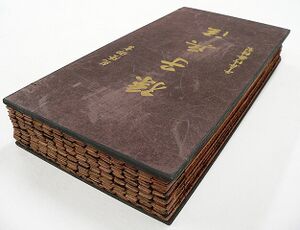The Art of War (Chinese: 孫子兵法; lit. 'Sun Tzu's Military Method', pinyin: Sūnzǐ bīngfǎ) is an ancient Chinese military treatise dating from the Late Spring and Autumn Period (roughly 5th century BC). The work, which is attributed to the ancient Chinese military strategist Sun Tzu ("Master Sun"), is composed of 13 chapters. Each one is devoted to a different set of skills or art related to warfare and how it applies to military strategy and tactics. For almost 1,500 years it was the lead text in an anthology that was formalized as the Seven Military Classics by Emperor Shenzong of Song in 1080. The Art of War remains the most influential strategy text in East Asian warfare and has influenced both East Asian and Western military theory and thinking and has found a variety of applications in a myriad of competitive non-military endeavors across the modern world including espionage, culture, politics, business, and sports.
The book contains a detailed explanation and analysis of the 5th-century BC Chinese military, from weapons, environmental conditions, and strategy to rank and discipline. Sun also stressed the importance of intelligence operatives and espionage to the war effort. Considered one of history's finest military tacticians and analysts, his teachings and strategies formed the basis of advanced military training for millennia to come.
The book was translated into French and published in 1772 (re-published in 1782) by the French Jesuit Jean Joseph Marie Amiot. A partial translation into English was attempted by British officer Everard Ferguson Calthrop in 1905 under the title The Book of War. The first annotated English translation was completed and published by Lionel Giles in 1910. Military and political leaders such as the Chinese communist revolutionary Mao Zedong, Japanese daimyō Takeda Shingen, Vietnamese general Võ Nguyên Giáp, and American military generals Douglas MacArthur and Norman Schwarzkopf Jr. are all cited as having drawn inspiration from the book.
Table of contents
Chapter 3. Attack by Stratagem
Chapter 4. Tactical Dispositions
Chapter 6. Weak Points and Strong
Chapter 7. Maneuvering
Chapter 8. Variation of Tactics
Chapter 9. The Army on the March
Chapter 10. Terrain
Chapter 11. The Nine Situations
Chapter 12. The Attack by Fire
Chapter 13. The Use of Spies
Chinese Concordance
Index
